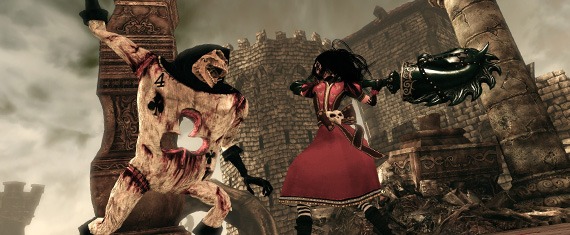 I was a huge fan of the original American McGee’s Alice, a somewhat-fringe PC game that took the already-twisted story of Alice in Wonderland and turned it on its sadistic ear. A slightly-mad Alice slicing her way through evil playing-card guards? Yep, the gameplay novelty rocked, but it was the environments and overall personality of the game that really won me over. When EA announced Alice: Madness Returns, I couldn’t wait to see what Mr. McGee had up his sleeve, and the fact that the original Alice was included as free DLC was icing on my anticipatory cake.
I was a huge fan of the original American McGee’s Alice, a somewhat-fringe PC game that took the already-twisted story of Alice in Wonderland and turned it on its sadistic ear. A slightly-mad Alice slicing her way through evil playing-card guards? Yep, the gameplay novelty rocked, but it was the environments and overall personality of the game that really won me over. When EA announced Alice: Madness Returns, I couldn’t wait to see what Mr. McGee had up his sleeve, and the fact that the original Alice was included as free DLC was icing on my anticipatory cake.
I must have hyped myself up a bit too much, because Alice: Madness Returns is somewhat disappointing. The environments are much more detailed than the original, a testament to how far technology has evolved in the past decade, and the personality of Alice and the NPCs doesn’t miss a stride from where the original Alice left off. But where American McGee’s Alice provided a nice mix of platforming, action and puzzle solving, Alice: Madness Returns includes those same elements in a much more clumped-together format, giving the feeling that the gameplay mechanics really aren’t all that diverse.
The game itself is a straight-up sequel to the original, with Alice returning to Wonderland to finally come to terms with her inner demons about losing her family in a devastating fire. Throughout the game she encounters a host of old, familiar foes who want to stand in the way of that resolution, as well as some new enemies that provide new combat challenges. Most battles plays out like a Legend of Zelda or other adventure game, with certain enemy types and mini-bosses having specific points of vulnerability and attack patterns, while the grunt-type enemies just require some good old-fashioned knife-slashing or ranged attacks. Weapons can be upgraded after collecting and redeeming special orbs, and secret areas are accessible by either shrinking Alice in size or navigating a series of platforming obstacles.

It all sounds good, and by and large the game has all the right pieces. However, the manner in which all those pieces are assembled leaves something to be desired. I worked with a magazine editor once who said “lots of people like chocolate, and lots of people like broccoli, but they’ll get tired of it if you give them too much at any one time. You have to space it out, give them little bits at a time, and they’ll enjoy every bite.” Alice: Madness Returns has lots of chocolate. It has lots of broccoli. I happen to like both. The problem is that while the platforming elements, puzzle solving and combat are all good, they’re presented all at once rather than sprinkled diversely throughout the experience, which grows tiring after a while.
Case in point: about six hours into the game, Alice is making her way through a castle area and faces a host of troll-like guards who want nothing more than to deliver on the Queen’s decree to lop off her head. Alice begins by navigating a 10-minute platforming section, then moves on to 5-7 minutes of combat, then moves on to more platforming, then has a puzzle to solve — and if you happen to die in any of those parts, you have to re-do the entire process. Spacing the enemies apart and/or sprinkling the platforming among the other gameplay elements would have been ideal, because as it’s structured this section feels tiring. And not in a good way.
Much of the game plays out this way, with large chunks of any one activity grouped together before moving on to the next clump of gameplay mechanic. Again, the individual gameplay elements are solid, with some challenging platforming sections, creative puzzles and, quite frankly, a combat system that’s incredibly more advanced and enjoyable than the original American McGee’s Alice. It’s just that more attention should have been paid to the diversity and structure, so people didn’t have to eat a whole Hershey bar before downing two pounds of broccoli florets.
In terms of the game’s graphics, Alice: Madness Returns does a great job balancing the original’s character-model and environmental vibe with the HD demands of modern gamers. Nothing looks too lifelike or realistic, but it’s not supposed to in a fantasy world like this. The weapons are all creative as Hell, as are the environments, and the enemy types are diverse enough with their armor and configurations that you don’t feel like you’re battling 10,000 of the same faceless foe. Certain elements of the game look slightly dated, but I don’t think it’s any fault of the engine. Rather, I think it was a design decision to bridge the gap between the 10-year-old original and this year’s release.
The audio is good when it needs to be, particularly when it comes to the surround-sound elements. However, I was a bit disappointed in the environmental audio and soundtrack, because until an enemy appears or Alice does something, there’s little in the way of ambient sound. A low-volume soundtrack or other environmental sounds would’ve gone a long way in terms of immersion. But, where the combat is concerned or when Alice is engaged in a core activity, the sound effects are fine.
Does “fine” cut it, though, even when we’re in the annual summer doldrums? I don’t think so, especially when that’s the general vibe of the entire game. I had high hopes for Alice: Madness Returns, but perhaps they were too high. You often find games where the phrase “the whole is greater than the sum of its parts” applies perfectly, but it’s not all that common to find a game where the individual components of the recipe are better than the finished dish. That’s what you get with Alice: Madness Returns. The combat, platforming, puzzle-solving and action are all good, but how they’re assembled isn’t nearly as fulfilling.
If you’d like to check the game’s pricing on Amazon, click the following links: Alice: Madness Returns for PS3, or Alice: Madness Returns for Xbox 360
.
Score: 7.9 — The levels are creative and artistic direction is solid, but the actual gameplay suffers from a lack of diversity and being clumped into big chunks.
Platform reviewed: Xbox 360
